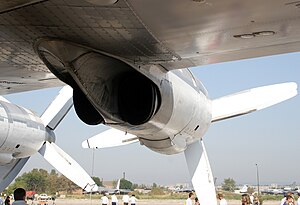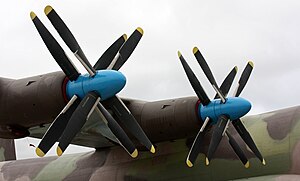| NK-12 | |
|---|---|
| NK-12M Turboprop engine on a Tu-95 at RIAT Fairford 1993 |

The exhaust ports of a NK-12 in an outboard nacelle on a TU-95

A pair of Kuznetsov NK-12MAs installed on an Antonov An-22
The Kuznetsov NK-12 is a Soviet turboprop engine of the 1950s, designed by the Kuznetsov design bureau. It drives two large four-bladed (eight blades per engine) contra-rotating propellers, 5.6 m (18 ft 4.5 in) in diameter, and 6.2 m (20 ft 4.1 in) in the NK-12MA and NK-12MV. It is the most powerful turboprop engine to enter service.
Design and development[]
The design that eventually became the NK-12 turboprop was developed after World War II by a team of Russian scientists and deported German engineers under Ferdinand Brandner, who had worked for Junkers previously; the design bureau was headed by chief engineer Nikolai D. Kuznetsov. Thus, the NK-12 design evolved from late-war German turboprop studies. This started with the postwar development of the wartime Jumo 022 turboprop design that developed 6000 eshp in a 3000 kg (6,600 lb) engine. The effort continued with a 5000 ehp engine that weighed in at 1700 kg (3,740 lb), completed by 1947. The evolution to the TV-12 12000 Ehp engine required extensive use of new Soviet-developed alloys and was completed in 1951.[1]
The NK-12M developed 8,948 kW (12,000 ehp), uprated in the NK-12MV to 11,033 kW (14,795 ehp) and reaching 11,185 kW (15,000 ehp) in the NK-12MA. The NK-12 remains the most powerful turboprop engine to enter service although the Progress D-27 and Europrop TP400 have come close to this (in 1982 and 2005 respectively). Another engine of similar size, the Pratt & Whitney T57 with 15,000 shp and 5,000 lb jet thrust, ran 3,100 hours before being cancelled in 1957.[2][3] The NK-12 powers the Tupolev Tu-95 bomber and its derivatives such as the Tu-142 maritime patrol aircraft and the Tupolev Tu-114 airliner (with NK-12MV), which still holds the title of the world's fastest propeller-driven aircraft despite being retired from service in 1991. It also powered the Antonov An-22 Antei (with NK-12MA), the world's largest aircraft at the time, and several types of amphibious assault craft, such as the A-90 Orlyonok "Ekranoplan".
The engine has a 14-stage axial-flow compressor, producing compression ratios between 9:1 and 13:1 depending on altitude, with variable inlet guide vanes and blow-off valves for engine operability. The combustion system used is a cannular-type: each flame tube is centrally mounted on a downstream injector that ends in an annular secondary region. The contra-rotating propellers and compressor are driven by the five-stage axial turbine. Mass flow is 65 kg (143 lb) per second.[4]
Applications[]
- A-90 Orlyonok
- Antonov An-22
- Tupolev Tu-95
- Tupolev Tu-114
- Tupolev Tu-116
- Tupolev Tu-126
- Tupolev Tu-142
Specifications[]
- General characteristics
- Type: turboprop
- Length: 4.8 m[4] (199 ins.)
- Diameter: 1.2 m[4] (47 ins.)
- Dry weight: 2,900 kg (6393 lbs), for NK-12MV
- Components
- Performance
- Maximum power output: 11,033 kW (14,795 ehp), for NK-12MV
- Overall pressure ratio: 9.5[4]
- Turbine inlet temperature: 1250 K[4]
- Specific fuel consumption: 0.360 lb/shp-hr [5] 0.219 kg/kW-hr for NK-12MA and NK-12MV
- Power-to-weight ratio: 3.7 kW/kg (2.3 hp/lb), for NK-12MV
See also[]
- List of aircraft engines
References[]
- ↑ Kuznetsov NK-12 (Russian Federation) - Jane's Aero-Engines
- ↑ "The Engines of Pratt & Whitney A Technical History, Jack Connors, AIAA Inc., ISBN 978-1-60086-711-8 p.294
- ↑ "Advanced Engine Development at Pratt & Whitney", Dick Mulready, SAE INternational, ISBN 0-7680-0664-3 p.20
- ↑ 4.0 4.1 4.2 4.3 4.4 4.5 4.6 Creation of the TV-2 (NK-12) turboprop engine
- ↑ Civil Turboshaft/Turboprop Specifications
External links[]
| Wikimedia Commons has media related to Category:Kuznetsov NK-12. |
The original article can be found at Kuznetsov NK-12 and the edit history here.
